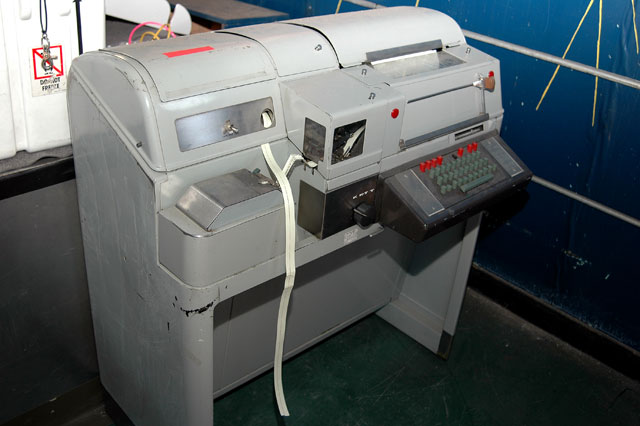Page 2/2 - Posted June 10, 2011
CosRay experiment adapts with the timesThe neutron monitor at McMurdo has 18 cosmic ray counters. They are arranged in three units, each with six tube-shaped counters. Each unit is covered with polyethylene slabs that hold six stainless steel tubes surrounded by polyethylene sleeves. Some 50 tons of lead rings surround the tubes, which are filled with a gas called boron trifluoride. A thin wire runs through the gas down the center of the tube and connects to an amplifier. Today, a computer records the data and sends it to Bartol, which makes the information available in real-time. But, back in the old days, that job was handled by a teletype machine that recorded and printed the data. These and other pieces of equipment — including a “bit bucket” still filled with bits of paper punched out by the teletype machine — still linger in the CosRay Observatory building, a rectangular structure that sits on the road to New Zealand’s Scott Base The original experiment had been located in the research town proper. But construction of a nuclear power plant on the side of Observation Hill overlooking McMurdo in the early 1960s required relocating CosRay to a new site. The experiment would have detected the neutrons from the nuclear power plant, which operated for about a decade before it was shut down due to safety concerns. [See related article: Powerful reminder: Plaque dedicated to former McMurdo nuclear plant marks significant moment in Antarctic history] “You couldn’t have a neutron monitor measuring cosmic rays next to a nuclear reactor,” Evenson noted. Its location on the other side of Ob Hill shielded it from the neutrons emitted from the reactor. And now the venerable CosRay Observatory is once again being asked to accommodate the march of progress. But this time it’s not about nuclear energy but energy savings. The National Science Foundation [See related articles: Winding up: In another effort to save fuel, which arrives once per year on a tanker vessel, the NSF has decided to cut power to the CosRay building. Carpenters have been working on insulating the three neutron monitor units so that the experiment can continue in the cold. That project is scheduled for completion during the 2011-12 season when the sun is again predicted to get busy after a period of extreme inactivity. Despite its age, the CosRay Observatory is still a valuable source of data, according to Evenson, who is a collaborator on an experiment associated with the IceCube Neutrino Observatory called IceTop IceCube is an experiment with thousands of sensors frozen into the ice sheet under the South Pole Station looking for subatomic particles called neutrinos. IceTop uses identical instruments at the surface of the array to detect cosmic ray particles at higher energies than those counted by CosRay. Together, the two instruments from different eras can tackle new questions, such as whether the maximum particle energy in a solar flare event increases with the total energy release on the sun. In other words, do smaller solar flares produce particles the same distribution in energy as larger events? “We’re hoping the sun gives us some events to answer some really interesting questions,” Evenson said. NSF-funded research in this story: John Bieber and Paul Evenson, University of Delaware, Award No. 0739620; and Paul Evenson, University of Delaware, Award Nos. 0838838 and 0838839
|



For USAP Participants |
For The Public |
For Researchers and EducatorsContact UsU.S. National Science FoundationOffice of Polar Programs Geosciences Directorate 2415 Eisenhower Avenue, Suite W7100 Alexandria, VA 22314 Sign up for the NSF Office of Polar Programs newsletter and events. Feedback Form |




